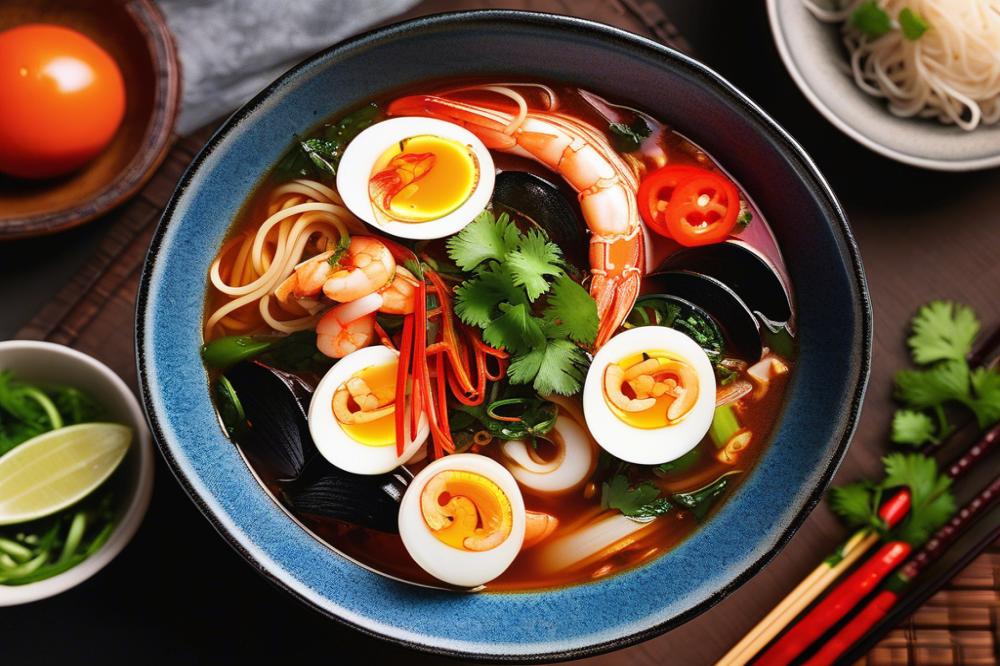Exploring Jjampong: A Korean Culinary Treasure
Jjampong is a beloved dish in Korean cuisine. This spicy seafood noodle soup has gained popularity both in Korea and around the world. Its vibrant flavors and enticing aroma truly make it stand out among various Asian recipes.
In Korean culture, jjampong is not just food; it represents warmth and togetherness. Families often enjoy it during special occasions or while socializing with friends. A bowl of this hearty seafood soup is perfect for bringing people together, making it a staple on many dining tables.
The appeal of this noodle broth lies in its boldness. Diners can expect an exciting fusion of flavors, with the heat from the spices complementing the rich taste of fresh seafood. The combination of Korean noodles with an array of shellfish and vegetables creates a satisfying experience for anyone who loves spicy food.
This dish is more than a meal; it is an exploration of tastes and textures. Each ingredient adds unique characteristics, resulting in a delightful and well-balanced bowl of nutrition. Properly following the jjampong recipe can lead to a delicious outcome that showcases the nature of this cherished culinary creation.
What is Jjampong
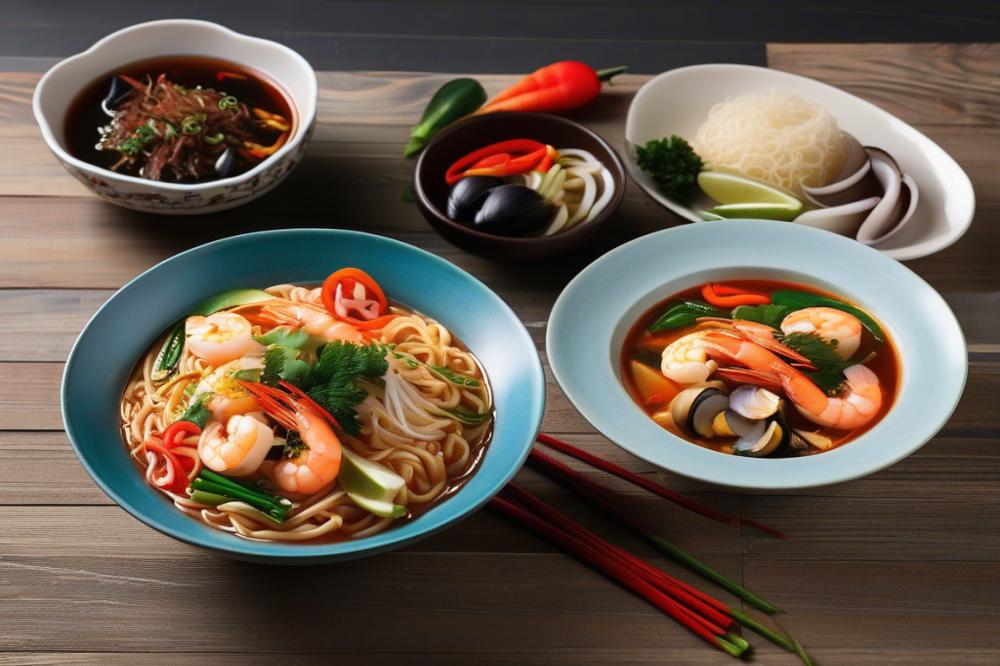

Jjampong is a hearty and flavorful dish that features spicy seafood and Korean noodles in a rich broth. Originating from the Chinese cuisine introduced through Chinese immigrants, this spicy soup has found a special place in Korean homes and restaurants. It combines various seafood ingredients such as shrimp, clams, and squid, giving it a robust taste.
Definition and Origin of Jjampong
This dish is often characterized by its bold and spicy taste. Traditionally, it includes wheat noodles cooked in a savory seafood broth, infused with spices that give it a distinctive heat. Over the years, jjampong has evolved from its Chinese roots into a popular Korean meal. Ingredients can vary, but the essence remains the same: rich seafood flavors brought together with spices.
Discussion of Regional Variations in Korea
In South Korea, jampong comes in many styles. Each region adds its own touch. For example, in Busan, the dish might feature more seafood due to its coastal location. On the other hand, the variation from inland areas may focus more on vegetables, reflecting local tastes. These differences make the jjampong recipe versatile and accessible.
Cultural Significance and Popularity Among Korean Dishes
This dish enjoys immense popularity, often appearing in family gatherings and celebrations. It is cherished for its comforting qualities and bold flavors, appealing to those who enjoy spicy food. Many Korean restaurants feature it on their menus, attracting diners looking for a warm and satisfying meal. People often share stories and experiences around a bowl of jjampong, making it more than just a seafood soup; it’s a cultural experience.
Ingredients List for Jjampong
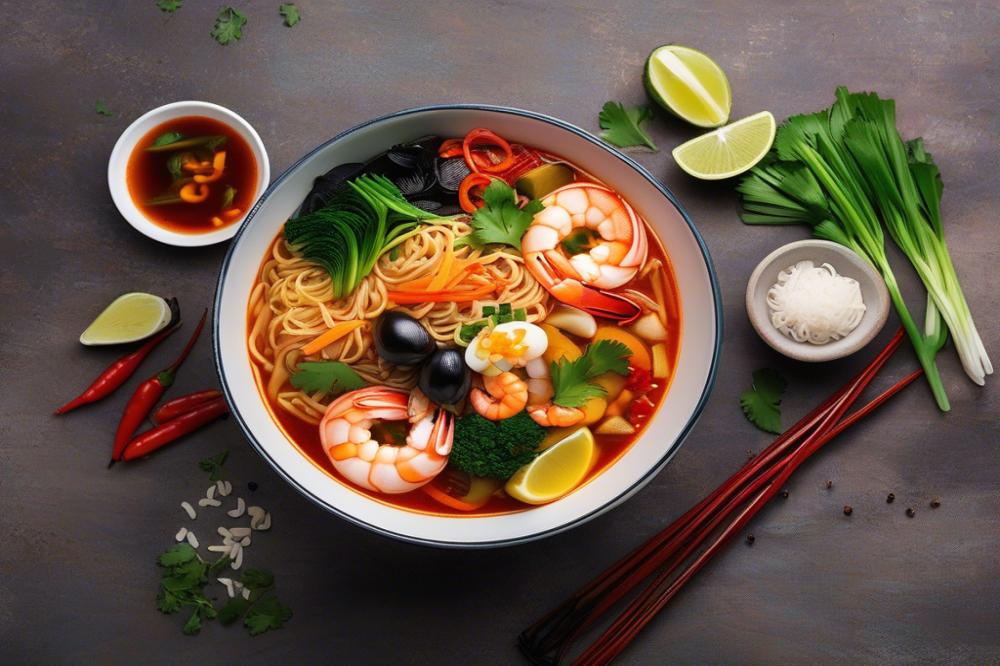

To create a delicious spicy seafood noodle soup, gather the following ingredients:
- Korean noodles (400g)
- Mixed seafood (300g) such as shrimp, mussels, and squid
- Vegetable broth (1 liter)
- Garlic (4 cloves, minced)
- Ginger (1 inch, minced)
- Korean chili powder (2 tablespoons)
- Soy sauce (2 tablespoons)
- Sesame oil (1 tablespoon)
- Green onions (2, chopped)
- Carrots (1, julienned)
- Zucchini (1, julienned)
- Bell pepper (1, sliced)
- Bean sprouts (150g)
- Salt and pepper to taste
Each ingredient plays a specific role in the overall flavor. Korean noodles serve as the foundation of this dish. They are chewy and provide substance. Mixed seafood adds depth and a variety of textures, with shrimp and squid bringing unique flavors to the seafood soup.
Vegetable broth is the heart of the spicy soup, offering a rich background for all the ingredients. Garlic and ginger contribute aromatic qualities. They also boast health benefits, such as anti-inflammatory properties and supporting digestion. Korean chili powder is essential for its heat and vibrant color, making the jjampong recipe truly special.
Soy sauce adds a savory umami flavor, enhancing the overall taste. A touch of sesame oil elevates the dish with a nutty aroma. Green onions give freshness, while carrots, zucchini, and bell pepper provide color and crunch. These vegetables also offer fiber and vitamins, making the soup not just spicy but also nutritious. Finally, bean sprouts lend a crisp texture, completing the dish.
Season with salt and pepper to suit your personal preferences. This step allows you to adjust the flavors to your liking. Overall, preparing this Asian recipe involves a mix of simple yet effective ingredients. The combination creates a warming noodle broth that is both satisfying and invigorating.
Cooking Instructions
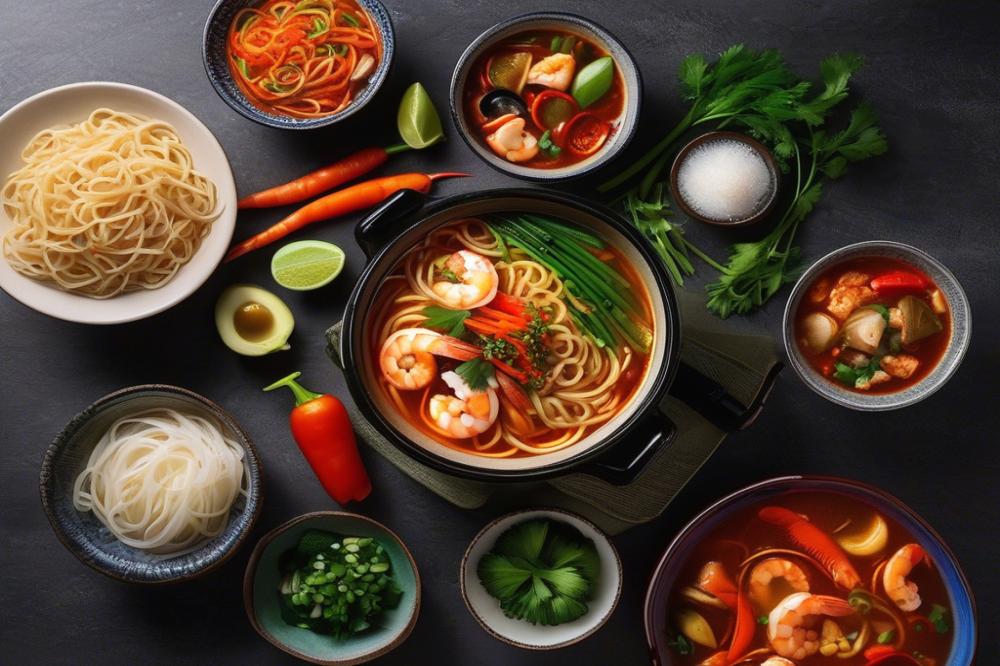

Step-by-step guide to preparing Jjampong
Start by gathering all your ingredients. A good jjampong recipe includes a variety of seafood, such as shrimp, mussels, and squid. Korean noodles are a must for this dish. You’ll also need vegetables like cabbage, carrots, and green onions.
Preparation of broth and noodles
First, make the noodle broth. Begin with a pot of water and bring it to a boil. Add the Korean noodles and cook them according to package instructions. While the noodles are cooking, prepare the broth. Use a combination of water or seafood stock, along with garlic, ginger, and a few chili flakes for spice. Simmer the broth gently to enhance its flavors. A good broth is the foundation of any seafood soup.
Cooking the seafood and vegetables
Once your broth is ready, it’s time to add the seafood. Start with the tougher seafood first, like squid, since it takes longer to cook. After a couple of minutes, add the shrimp and mussels. These seafood options cook quickly, so keep an eye on them. Next, toss in your chosen vegetables. Cabbage and carrots should be added last to retain their crunchiness. Stir everything gently to ensure even cooking.
Combining ingredients for the final soup
Drain the noodles when they are done. Place them in a large bowl. Carefully ladle the cooked seafood and vegetables over the noodles. Pour the flavorful broth on top, filling the bowl with steaming soup. This method will keep the noodles hot without overcooking them.
Tips for achieving the right balance of spices
Balancing spices is essential in cooking spicy food. Taste your broth before serving. If it needs more heat, add extra chili oil or sauce. You can also sprinkle in some black pepper for an additional kick. Remember that everyone has different spice tolerances. Always adjust according to your family’s preference. Adding fresh herbs, like cilantro, just before serving can enhance the dish. Jjampong is best enjoyed hot, so serve it immediately for maximum flavor and warmth.
Serving Suggestions
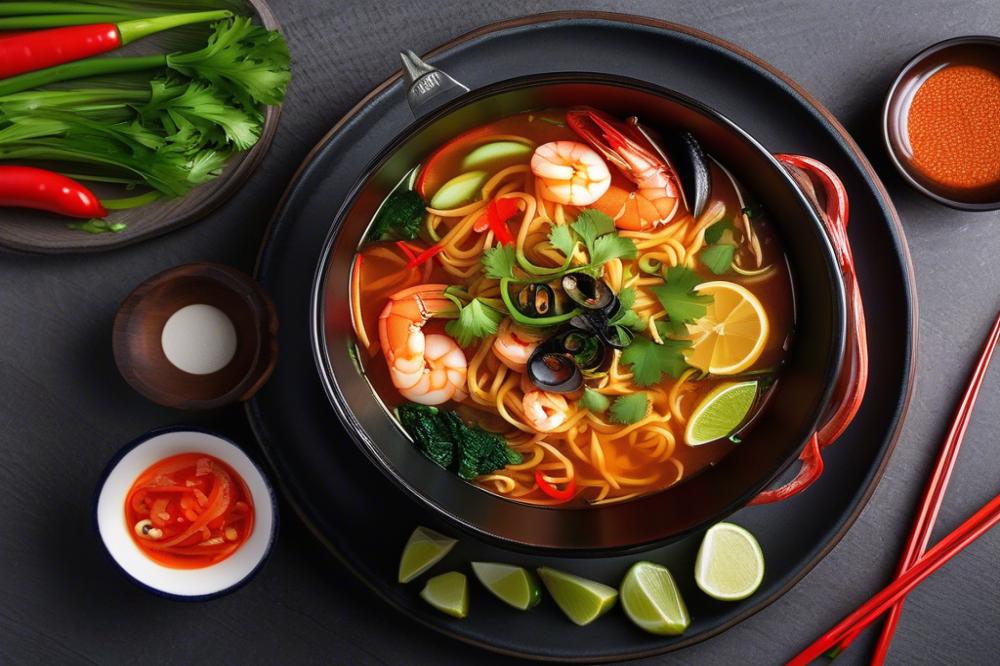

When serving your homemade spicy seafood noodle soup, consider the presentation. Servings should be hot and steaming, served in deep bowls that hold a sizable portion. This spicy dish is best enjoyed immediately after cooking, as the flavors meld beautifully but can dull if left to sit.
Best Practices for Serving Jjampong
Whenever possible, use chopsticks alongside a spoon for an authentic experience. The noodles can be slurped up easily with chopsticks, while the broth and seafood can be sipped with a spoon. It’s a delightful way to enjoy the layers of texture and taste. Some prefer to sprinkle a dash of chili powder over the top for an extra kick. This simple step can enhance the soup’s vibrant appearance and flavor.
Garnishing Ideas
Adding garnishes can elevate the dish to another level. Lime wedges, cilantro sprigs, or a sprinkle of sesame seeds work wonderfully. Just before serving, squeeze a wedge of lime over the soup for a refreshing burst of acidity. Cilantro adds a bright, herbal note that complements the spicy broth. Rarely does a garnish go unappreciated in dishes like this. Sesame seeds can provide a satisfying crunch. Their unique taste also works well with the dish’s overall character.
Pairing with Side Dishes
Think about serving the soup alongside traditional side dishes from Korean cuisine. Kimchi, a fermented vegetable dish, offers a tangy and spicy bite that pairs nicely. Another popular choice is pickled radish, which adds crunch and bright flavor. Rice, either plain or seasoned, can absorb the rich broth and balance the heat. These accompaniments create a harmonious meal, ensuring a delightful culinary experience.
For those who enjoy spicy food, this soup can be the centerpiece of a lovely dinner. A well-prepared jjampong recipe can impress friends and family alike. With thoughtful garnishes and side dishes, you can turn a simple seafood soup into a memorable dining experience.
Variations of Jjampong
Jjampong offers exciting opportunities for personalization. Many enjoy experimenting with different ingredients to create flavorful experiences. Various styles exist, reflecting regional preferences in Korean cuisine. Busan-style jjampong is particularly famous for its rich flavor and seafood variety. Other variations may include adding different vegetables, such as mushrooms or zucchini, to enhance the dish’s texture and taste.
Exploring Different Styles of Jjampong
Regional variations truly showcase the flexibility of this seafood soup. For instance, some recipes may incorporate clams, squid, or even crab for unique flavors. Others might focus on the broth by experimenting with anchovy broth instead of the usual base. Factors like the type of Korean noodles used can also change the entire experience. Fresh noodles provide a chewy texture, while dried ones can deliver a different bite.
Substitutions for Seafood and Vegetarian Options
Those who prefer not to use seafood have plenty of alternatives. Tofu can serve as an excellent protein source for a vegetarian option. Additionally, adding mushrooms, bell peppers, and green onions creates a delightful medley of flavors. If someone wants to try a plant-based version, vegetable broth works wonderfully. This can provide a savory base while still allowing for robust taste without the seafood.
Spiciness Levels and How to Adjust
Spice lovers might appreciate the heat that jjampong brings. The chili powder used in the jjampong recipe can be adjusted according to individual tolerance. A milder taste can result from reducing the amount of chili. Moreover, adding sugar or coconut milk can help balance the soup’s heat. Always taste the broth before serving to find the perfect heat level for everyone at the table.
Final Thoughts on Preparing Jjampong
Summary of the Jjampong Preparation Process
Creating this spicy seafood noodle soup involves several key steps. First, gather the essential ingredients like various seafood, vegetables, and noodles. Begin by stir-frying garlic and ginger to build a fragrant base. Next, add the seafood along with a mix of flavorful spices and broth. Cooking everything together allows the ingredients to meld and develop a rich taste. Finally, incorporate the Korean noodles just before serving. This process not only highlights the freshness of seafood but also brings out the warmth of the spices.
The Joys of Making and Enjoying This Spicy Seafood Noodle Soup
There’s something delightful about making Jjampong as the aromas fill your kitchen. Each step feels rewarding, from the sizzling of ingredients to the vibrant colors in your bowl. Sharing the soup with friends or family enhances the experience even more, as everyone can bond over its deliciousness. Savoring a warm bowl on a chilly day can lift your spirits, making it a comforting dish as well.
Encouragement to Try Making Jjampong at Home
Taking the plunge to prepare this dish at home can be quite thrilling. It’s an opportunity to explore more about Korean cuisine and its unique flavors. Feel free to customize the seafood and spice levels to suit your taste. Whether you prefer shrimp, squid, or clams, the possibilities are endless. Enjoying your homemade seafood soup can lead to new discoveries and deeper appreciation for cooking. Don’t hesitate—try making it yourself. You’ll find joy in every steaming, flavorful bite.

